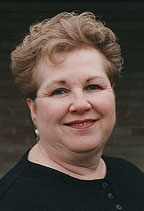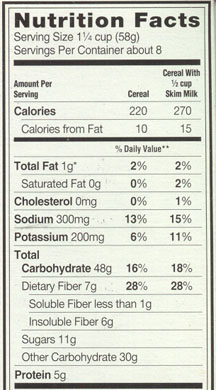 Prepared by:
Prepared by:
Donna Montgomery, M.S.
Page 4 of 4
Ten health claims about the relationships
between a nutrient or a food and the risk of a disease or health-related
issue are now permitted on food labels.
|
|
Click here for the printable (Word) version of the lesson
Health
Claims
Ten health claims about the relationships between a nutrient
or a food and the risk of a disease or health-related issue are
now permitted on food labels. These claims are based on sound
research. Claims are approved in 10 areas:
- Calcium and osteoporosis
- Sodium and hypertension (high blood pressure)
- Dietary fat and cancer
- Dietary saturated fat and cholesterol and risk of coronary
heart disease
- Fiber-containing grain products, fruits and vegetables and
cancer
- Fruits, vegetables and grain products that contain fiber,
particularly soluble fiber and risk of heart disease
- Fruits and vegetables and cancer
- Folic acid and neural tube birth defects.
- Dietary sugar alcohols and dental caries (cavities).
- Dietary soluble fiber, such as that found in whole oats and
psyllium seed husk and coronary heart disease.
Summary
 Take a minute to brainstorm. List
the 10 top reasons for reading a food label. Take a minute to brainstorm. List
the 10 top reasons for reading a food label.
Take a look at one of the food packages you pulled from your
pantry. Write down five things that the label tells you about
the food inside.
Suppose you were choosing a breakfast cereal. What might make
you buy one over the other? How would you decide which one had
the nutrients you need? The Nutrition Facts panel on the
label can help you compare the calories and nutrients of these
cereals, and help you make an informed choice.
Reading a food label helps you make food choices within the Food
Guide Pyramid. The food label is good reading for healthy eating.
You can tell a lot about a food just by reading the label. This
is one of the best sources of information available to you.
Remember, the Dietary Guidelines, Food Guide Pyramid and Nutrition
Facts label work together to help you and your family eat
more healthfully. The Dietary Guidelines set up guidelines for
Americans households follow to maintain health. The Food Guide
Pyramid is a picture guide based on the Dietary Guidelines, and
the food label helps you to make healthy choices within these
groups. Here's wishing you and your family healthy eating!
Web
Sites to Visit and Other Assignments
Web Site Assignments
Explore this web site http://www.nutritioncamp.com/index.html.
This is a Kellogg's web site. Go to the Learning Lab and
then click on Label Lore. See what you can learn.
This site has activities for you to complete to practice what
you have learned.
Visit the web site http://www.phys.com
as discussed earlier in the lesson within the section, Nutrition
Facts Label.
Other Assignments
On your next trip to the grocery store, compare the following
foods:
- frozen green beans and canned green beans for sodium content
- skim milk, low-fat milk, reduced-fat milk and whole milk
for fat and calcium content
- various breakfast cereals for fiber content
- frozen dinners for nutrition, convenience and cost
- soft drinks for nutrition and cost
- chips for nutrition and cost
References
Browne, Mona Boyd. Label Facts for Healthful
Eating. Educator's Resource Guide.
National Food Processors Association in Cooperation with FDA
and USDA.. 1993.
Facts About the New Food Label. American Heart Association. 1993.
FDA Consumer, Focus on Food Labeling. FDA Consumer Special Report.
May, 1993.
Nutrition Labeling of Meat and Poultry. FSIS Backgrounder. 1991.
The New Food Label. FDA Backgrounder. 1991.
The New Food Label and You. USDA Food Safety and Inspection Service.
1993.
The New Food Label...There's Something in it for Everybody. Department
of Health and Human Services, Food and Drug Administration and
International Food Information Council. July, 1994.
   [ LESSONS || SITE
MAP || LOCAL AGENTS || RESOURCES || PEOPLE ]
[ LESSONS || SITE
MAP || LOCAL AGENTS || RESOURCES || PEOPLE ]
 Issued in furtherance of Cooperative Extension
work, Acts of Congress of May 8 and June 30, 1914, in cooperation
with the United States Department of Agriculture. The Louisiana
Cooperative Extension Service provides equal opportunities in
programs and employment. Information and Graphics on this site
are copyright protected by LSU Agricultural Center's Louisiana Cooperative Extension Services.
For more information
on the EFNEP program, contact EFNEPMail@agcenter.lsu.edu. Issued in furtherance of Cooperative Extension
work, Acts of Congress of May 8 and June 30, 1914, in cooperation
with the United States Department of Agriculture. The Louisiana
Cooperative Extension Service provides equal opportunities in
programs and employment. Information and Graphics on this site
are copyright protected by LSU Agricultural Center's Louisiana Cooperative Extension Services.
For more information
on the EFNEP program, contact EFNEPMail@agcenter.lsu.edu.
|